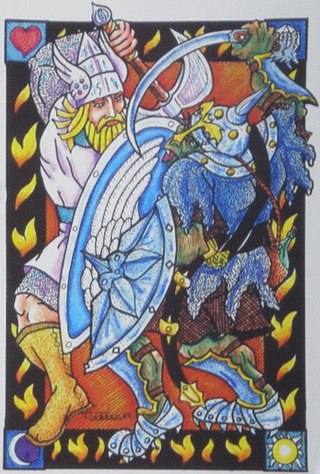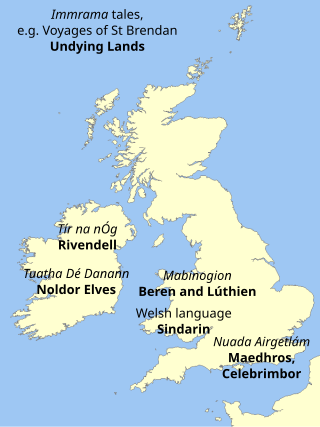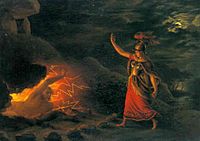Beorn is a character created by J. R. R. Tolkien, and part of his Middle-earth legendarium. He appears in The Hobbit as a "skin-changer", a man who could assume the form of a great black bear. His descendants or kinsmen, a group of Men known as the Beornings, dwell in the upper Vales of Anduin, between Mirkwood and the Misty Mountains, and are counted among the Free Peoples of Middle-earth who oppose Sauron's forces during the War of the Ring. Like the powerful medieval heroes Beowulf and Bödvar Bjarki, whose names both mean "bear", he exemplifies the Northern courage that Tolkien made a central virtue in The Lord of the Rings.
Thorin Oakenshield is a fictional character in J. R. R. Tolkien's 1937 novel The Hobbit. Thorin is the leader of the Company of Dwarves who aim to reclaim the Lonely Mountain from Smaug the dragon. He is the son of Thráin II, grandson of Thrór, and becomes King of Durin's Folk during their exile from Erebor. Thorin's background is further elaborated in Appendix A of Tolkien's 1955 novel The Return of the King, and in Unfinished Tales.
Boromir is a fictional character in J. R. R. Tolkien's legendarium. He appears in the first two volumes of The Lord of the Rings, and is mentioned in the last volume, The Return of the King. He was the heir of Denethor II and the elder brother of Faramir. In the course of the story Boromir joined the Fellowship of the Ring.

Rivendell is a valley in J. R. R. Tolkien's fictional world of Middle-earth, representing both a homely place of sanctuary and a magical Elvish otherworld. It is an important location in The Hobbit and The Lord of the Rings, being the place where the quest to destroy the One Ring began.
In the fantasy of J. R. R. Tolkien, the Dwarves are a race inhabiting Middle-earth, the central continent of Arda in an imagined mythological past. They are based on the dwarfs of Germanic myths who were small humanoids that lived in mountains, practising mining, metallurgy, blacksmithing and jewellery. Tolkien described them as tough, warlike, and lovers of stone and craftsmanship.
In J. R. R. Tolkien's Middle-earth fiction, Man and Men denote humans, whether male or female, in contrast to Elves, Dwarves, Orcs, and other humanoid races. Men are described as the second or younger people, created after the Elves, and differing from them in being mortal. Along with Ents and Dwarves, these are the "free peoples" of Middle-earth, differing from the enslaved peoples such as Orcs.

Arwen Undómiel is a fictional character in J. R. R. Tolkien's Middle-earth legendarium. She appears in the novel The Lord of the Rings. Arwen is one of the half-elven who lived during the Third Age; her father was Elrond half-elven, lord of the Elvish sanctuary of Rivendell, while her mother was the Elf Celebrian, daughter of the Elf-queen Galadriel, ruler of Lothlórien. She marries the Man Aragorn, who becomes King of Arnor and Gondor.
Mithril is a fictional metal found in J. R. R. Tolkien's Middle-earth writings. It is described as resembling silver, but being stronger and lighter than steel. It was used to make armour, such as the helmets of the citadel guard of Minas Tirith, and ithildin alloy, used to decorate gateways with writing visible only by starlight or moonlight. Always extremely valuable, by the end of the Third Age it was beyond price, and only a few artefacts made of it remained in use.
Gil-galad is a fictional character in J. R. R. Tolkien's Middle-earth legendarium, the last high king of the Noldor, one of the main divisions of Elves. He is mentioned in The Lord of the Rings, where the hobbit Sam Gamgee recites a fragment of a poem about him, and The Silmarillion. In the Last Alliance of Elves and Men, Gil-galad and Elendil laid siege to the Dark Lord Sauron's fortress of Barad-dûr, and fought him hand-to-hand for the One Ring. Both Gil-galad and Elendil were killed, while Elendil's son Isildur defeated Sauron but took the Ring for himself. Gil-galad briefly appears at the opening of Peter Jackson's The Lord of the Rings film trilogy, and in several video games based on Middle-earth and as a secondary character in the TV series The Rings of Power.
Elendil is a fictional character in J. R. R. Tolkien's legendarium. He is mentioned in The Lord of the Rings, The Silmarillion and Unfinished Tales. He was the father of Isildur and Anárion, last lord of Andúnië on the island of Númenor, and having escaped its downfall by sailing to Middle-earth, became the first High King of Arnor and Gondor. In the Last Alliance of Men and Elves, Elendil and Gil-galad laid siege to the Dark Lord Sauron's fortress of Barad-dûr, and fought him hand-to-hand for the One Ring. Both Elendil and Gil-galad were killed, and Elendil's son Isildur took the Ring for himself.
Barrow-wights are wraith-like creatures in J. R. R. Tolkien's world of Middle-earth. In The Lord of the Rings, the four hobbits are trapped by a barrow-wight, and are lucky to escape with their lives; but they gain ancient swords of Westernesse for their quest.

In mythology, legend or fiction, a magic sword is a sword with magical powers or other supernatural qualities. Renowned swords appear in the folklore of every nation that used swords.
Aragorn is a fictional character and a protagonist in J. R. R. Tolkien's The Lord of the Rings. Aragorn is a Ranger of the North, first introduced with the name Strider and later revealed to be the heir of Isildur, an ancient King of Arnor and Gondor. Aragorn is a confidant of the wizard Gandalf and plays a part in the quest to destroy the One Ring and defeat the Dark Lord Sauron. As a young man, Aragorn falls in love with the immortal elf Arwen, as told in "The Tale of Aragorn and Arwen". Arwen's father, Elrond Half-elven, forbids them to marry unless Aragorn becomes King of both Arnor and Gondor.

The One Ring, also called the Ruling Ring and Isildur's Bane, is a central plot element in J. R. R. Tolkien's The Lord of the Rings (1954–55). It first appeared in the earlier story The Hobbit (1937) as a magic ring that grants the wearer invisibility. Tolkien changed it into a malevolent Ring of Power and re-wrote parts of The Hobbit to fit in with the expanded narrative. The Lord of the Rings describes the hobbit Frodo Baggins's quest to destroy the Ring and save Middle-earth.

J. R. R. Tolkien invented heraldic devices for many of the characters and nations of Middle-earth. His descriptions were in simple English rather than in specific blazon. The emblems correspond in nature to their bearers, and their diversity contributes to the richly-detailed realism of his writings.
J. R. R. Tolkien's presentation of heroism in The Lord of the Rings is based on medieval tradition, but modifies it, as there is no single hero but a combination of heroes with contrasting attributes. Aragorn is the man born to be a hero, of a line of kings; he emerges from the wilds and is uniformly bold and restrained. Frodo is an unheroic, home-loving Hobbit who has heroism thrust upon him when he learns that the ring he has inherited from his cousin Bilbo is the One Ring that would enable the Dark Lord Sauron to dominate the whole of Middle-earth. His servant Sam sets out to take care of his beloved master, and rises through the privations of the quest to destroy the Ring to become heroic.

J. R. R. Tolkien derived the characters, stories, places, and languages of Middle-earth from many sources. Among these are the Celtic legends and languages, which for Tolkien were principally Irish and Welsh. He gave multiple conflicting reasons for his liking for Welsh. Tolkien stated directly that he had made use of Welsh phonology and grammar for his constructed Elvish language Sindarin. Scholars have identified multiple legends, both Irish and Welsh, as likely sources of some of Tolkien's stories and characters; thus for example the Noldorin Elves resemble the Irish Tuatha Dé Danann, while the tale of Beren and Lúthien parallels that of the Welsh Culhwch and Olwen. Tolkien chose Celtic names for the isolated settlement of Bree-land, to distinguish it from the Shire with its English names.

Tolkien derived the characters, stories, places, and languages of Middle-earth from many sources. Among these are Norse mythology, seen in his Dwarves, Wargs, Trolls, Beorn and the barrow-wight, places such as Mirkwood, characters including the Wizards Gandalf and Saruman and the Dark Lords Morgoth and Sauron derived from the Norse god Odin, magical artefacts like the One Ring and Aragorn's sword Andúril, and the quality that Tolkien called "Northern courage". The powerful Valar, too, somewhat resemble the pantheon of Norse gods, the Æsir.














